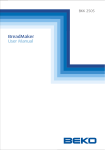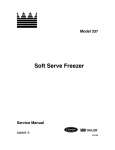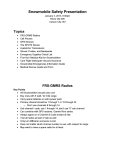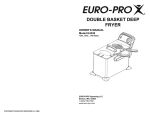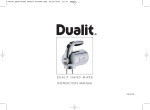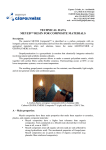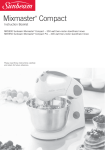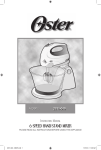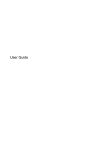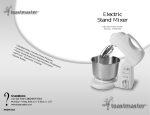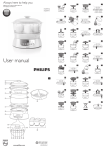Download Conclusions - Georgian College
Transcript
EVALUATING ACADEMIC READINESS FOR APPRENTICESHIP TRAINING Revised for ACCESS TO APPRENTICESHIP COMMUNICATIONS SKILLS DRAWING CONCLUSIONS AN ACADEMIC SKILLS MANUAL for The Food Preparation Trades This trade group includes the following trades: Baker & Cook, and Retail Meat Cutter Workplace Support Services Branch Ontario Ministry of Education and Training Revised 2011 In preparing these Academic Skills Manuals, we have used passages, diagrams and questions similar to those an apprentice might find in a text, guide or trade manual. This trade related material is not intended to instruct you in your trade. It is used only to demonstrate how understanding an academic skill will help you find and use the information you need. COMMUNICATIONS SKILLS DRAWING CONCLUSIONS An academic skill required for the study of the Food Preparation Trades INTRODUCTION Drawing conclusions means makings decision through a process of reasoning. It involves finding facts, examining opinions, and determining causes and effects. From this background, the relevant information is selected and used to reason through to the best conclusion. For example, it is getting difficult to cut through carrot tops with your cutting shears t. What conclusion can you draw that might lead to a solution to the problem? First you look for the relevant information. You check the manual to find out what kind of shears should be used for this job. You observe the strength of the shears and their condition. You reason that the dull edge on the blade is the cause of the problem. You come to the conclusion that you need to sharpen your shears. You have identified the problem and decided on a solution. As you can see, this is a useful process when you need to make a decision on the job, such as determining the best way to organize a kitchen so that it is efficient and safe to work in. When you think about the connection between what you observe and what you already know, you can come to a valid conclusion. You can use this conclusion to guide you in making workplace decisions. You draw conclusions by comparing information obtained from different sources. Your information might come from texts and manuals, from listening to knowledgeable workers and teachers and from experience gained working on projects. Here is an example from an everyday situation. Example: The ice on Lake Simcoe is thin, so you decide it won't be safe to snowmobile. Knowing the condition of the ice and the weight of a machine, you conclude there's a risk of an accident. The next day, when the newspaper reports a snowmobiler went through the ice, you realize you made the right conclusion. In this skills manual, we examine the process of drawing conclusions by looking at the following: Selecting information for valid conclusions Drawing valid conclusions Recognizing conclusions Communications Skills for the Food Preparation Trades Drawing Conclusions Page 1 Access to Apprenticeship Workplace Support Services Branch, Ontario Ministry of Education and Training Revised 2011 PART 1 SELECTING INFORMATION FOR VALID CONCLUSIONS A valid conclusion is one that is reasonable and that is based on fact as much as possible. The facts you use to draw a conclusion will come from instructors, textbooks, knowledgeable workers and your careful observations. Use this information and your experience to think through to a reasonable answer or solution – in other words, to a valid conclusion. Example: You are practicing the technique for beating egg whites using the following as a guide to getting stiff egg whites: Beating Egg Whites Follow the whipping technique and whip to the desired stage of soft, medium or stiff peaks: Stiff peak: Lift the whisk or beater from the egg whites. The egg whites will be firm and will stand up in stiff peaks that do not droop or flop over. The surface of the eggs will be moist and have a glossy appearance. You read the steps and followed directions carefully. What's more, you carefully cleaned the utensils, removing all grease to ensure volume in the egg whites. Still, there is moisture in the bottom of the bowl when you've reached the stiff peak stage. From your reading and observations, you know it should be dry. You look for information and see this note: Note: Avoid overbeating egg whites. They should not become too dry. Overbeating affects the protein and the moisture weeps out. Furthermore, although the egg whites may have great volume, the cells will not stretch adequately in the baking process. You have discovered that overbeating has an effect on the protein before the baking process and that is the cause of your problem. You have also learned that when egg whites are overbeaten, it will affect the baking process. You conclude that you need to make some changes to your whipping technique. You also conclude that the cause of this problem may apply to another other situation – failure of an egg white batter to rise during baking. You might take it one step further. Your whipping technique may result in overbeating in other situations as well. You will have to test this conclusion to discover if your problems in whipping cream, for example, have the same cause. Understanding Relationships Drawing a valid conclusion often depends on understanding the relationship between two things. In the example above, you first discovered that something unexpected is happening – stiff egg whites have moisture on the bottom. You follow these steps to find a cause for the problem: You look for information and read that whipping technique can cause moisture in egg whites. You reason that this could be a possible reason for the problem. You go back and notice that you whip your whites past the stiff stage. Communications Skills for the Food Preparation Trades Drawing Conclusions Page 2 Access to Apprenticeship Workplace Support Services Branch, Ontario Ministry of Education and Training Revised 2011 You test this idea by whipping for less time. If there is no moisture present, you can conclude that over whipping was the cause of the problem If there is still moisture, you need to keep looking. These steps are useful when you have a problem to solve. In many cases, looking at the relationship between different parts of a system will lead you to a reason for the problem. If one thing is not working the way it is supposed to, it can lead to difficulties in many areas. Using the following steps to observe cause and effect relationships can often lead to a solution or even prevent a problem in the first place. 1. 2. 3. 4. 5. 6. 7. You observe the situation You find information about what might cause this situation. You compare your information to what you see. You reach a conclusion about a likely cause. You check to see if the conclusion seems reasonable. You decide on an action based on your conclusion. After carrying out this course of action, you recheck to see if it solved the problem. Example: You read that dough is mixed with three parts flour, two parts fat and one part water. Changes to quantity, temperature or type of ingredient will change the quality of the pastry. Changes in the technique used can also affect the results. If you change: the proportions, the type or temperature of flour, water or fat mixing or sifting technique, you can conclude that any of the following will be affected by these changes: the appearance, the texture, and the flavour. This example describes the importance of using the correct portions, technique and ingredients in making pastry. Having this information will ensure that you follow recipe directions carefully when you make pastry. You can conclude from the example that if you make any changes, the result might not be satisfactory Note important details before you start a job. Read, ask questions, and use the information available to arrive at a practical conclusion as to how to carry out a job. Find out what factors will have an effect on the result. You may need to experiment and do some tests to check that you have drawn a logical conclusion. Communications Skills for the Food Preparation Trades Drawing Conclusions Page 3 Access to Apprenticeship Workplace Support Services Branch, Ontario Ministry of Education and Training Revised 2011 PART II DRAWING VALID CONCLUSIONS Sometimes you know the result, but not the exact cause. Example: When you read the newspaper report about the snowmobiler going through the ice on Lake Simcoe, you concluded that the ice was too thin for snowmobiling. This is probably true, but there could also be other factors involved. You might have a good idea of what happened but you might be missing some of the reasons for the problem. For example, being unfamiliar with the lake and travelling over an area of strong currents could be factors in the snowmobile accident. Bad visibility might also have been a factor. You can conclude that thin ice was the cause of the accident but you don’t know why the snowmobiler ended up over the unsafe ice in the first place. Getting all the pieces The same principle applies to paying attention to all the information concerning procedures you use at your workplace. If you make quick observations or if you skim through your manual, you might go ahead, assuming that you have all the pieces. But there is also the possibility that you have missed something. You can’t draw a valid conclusion or find a solution to a problem if you overlook important, available information. A valid conclusion relies on having, and examining, all of the information important to that situation. Read the passage below. Consider the conclusions you might draw from the information given. Answer the questions which follow. Answers are at the end of this skills manual. Hollandaise Sauce A Hollandaise sauce has variations that affect colour, flavour, texture and consistency among other qualities. When ingredients are in the correct ratio, the sauce has a buttery flavour. Add butter gradually to the egg yolks to achieve best consistency and to avoid curdling. Avoid a too hot sauce to prevent scrambling the eggs that will affect consistency. The ingredients that reduce the sauce will give a balance to the flavour. Variations to colour will result from the addition of ingredients such as tomato puree, but otherwise a pale yellow colour is desired. Questions 1. Your Hollandaise has a curdled appearance. You a) reduced the sauce too quickly. b) let the sauce become too hot. c) added butter to the egg yolks at the wrong time. d) added butter to the egg yolks too quickly. 2. The variations in a Hollandaise will mean a difference in a) colour, flavour, texture, and consistency. b) colour, flavour, texture, and consistency and other characteristics. c) all of the above, but primarily the consistency. Communications Skills for the Food Preparation Trades Drawing Conclusions Page 4 Access to Apprenticeship Workplace Support Services Branch, Ontario Ministry of Education and Training Revised 2011 3. A variation in colour most likely means that you added an ingredient that “coloured” the Hollandaise. T F Getting the whole picture Factors which are not stated may also affect the results of a job. For example, suppose you followed the instructions for making hollandaise and still produced a poor sauce. Is something else different? Is your equipment up to standard? Is there something you didn’t understand? When looking for the cause of a problem, you usually start with the obvious reasons. But sometimes you need to check out everything. Make sure you don’t reach a conclusion based on only part of the information. You want all the available information before drawing a conclusion. Always get the whole picture first. Example: Suppose you notice that the potatoes you are using have an unusually high spoilage rate. You know that your supplier has been providing your kitchen with excellent produce for several years, so you wonder what the problem might be. You contact the supplier and learn that other kitchens are not experiencing the same problem. You assume you may have just received an unusually poor lot, but the problem repeats with the next shipment. You begin to look for possible causes of the problem. You decide the problem may be due to a rearrangement of the vegetable storage area in the kitchen. In your research into storing and handling potatoes, you find this: Your choice of location can drastically affect the potatoes’ long-term usability: Warm temperatures encourage sprouting and tuber disease, Cold temperatures cause spuds to turn brown when fried, exposure to light prompts greening, Ventilation is critical. Sealed plastic containers starve tubers of oxygen and dry environments are downright withering. Note: Never store potatoes along with onions. When the two of them are put together, they produce certain gases that spoil both of them. You examine the storage area again and find that, indeed, there are onions fairly close to the potatoes. Can you conclude that the spoilage problem is caused by improper storage? It seems likely, so you separate the onions and potatoes and wait to see what happens. When the problem goes away, you decide that your conclusion was likely correct. In this example, your first conclusion was that you had a poor shipment. You based this on your past experiences. The problem started suddenly, so you checked with the supplier. You also checked with other kitchens to see if they had the same problem. However, when the spoilage problem continued, you realized that there was probably be another reason for it. Communications Skills for the Food Preparation Trades Drawing Conclusions Page 5 Access to Apprenticeship Workplace Support Services Branch, Ontario Ministry of Education and Training Revised 2011 From the information you found, you learned about another factor that might be causing the problem. You acted on that information by moving the onions and the problem disappeared. You draw a new conclusion based on further information and observation. Is it a valid conclusion? If a first conclusion doesn’t provide a practical solution, you have to keep looking. When you add new information, you should then be able to draw a different, and more valid, conclusion. In other words, new information can lead to a new conclusion when the first conclusion was not valid. Making an estimate for a catering job is one form of drawing a conclusion. To come up with a reasonable estimate requires several steps You have to know what options are available. You have to find out the cost of each option. You have to compare the advantages and disadvantages of each option. Then you have to weigh the cost against the advantages and disadvantages. You will have to decide what the most important factors are in making this decision. Reaching a final estimate involves coming to a conclusion as to what the best option is for the cost. You can now present this estimate to the customer along with reasons for your choices. To make sound decisions in the food preparation trade, you study information in texts, manuals and diagrams so that you learn the material and can apply it. You observe different factors in the workplace for the same reason - so you can understand and evaluate what you see. What you read (theory) and what you do (practice) are essential to making good decisions. You read and learn when working with written material; you observe and learn when gaining hands-on experience. Example: You experience a mild shock while using a hand blender. You take a good look at your blender and conclude that the damaged cord is the cause of the electrical shock. You unplug it carefully and set it aside until the cord is replaced. Here is another situation which calls for reaching a conclusion. Read the passage and answer the questions which follow. Answers are at the end of this skills manual. Vanilla Sauce Vanilla sauce or crème anglaise is a delightful accompaniment to hot desserts. Success depends on gentle cooking - gently cook eggs, milk (or cream), and sugar just to the point at which the mixture begins to thicken. The addition of flavouring ingredients can complement the main dish. Liqueurs, chocolate are common additions. Follow the method carefully to prevent curdling of this sauce. Keep heat low and stir constantly to 0 prevent overcooking. When properly cooked, cool as quickly as possible to below 40 F. Keep refrigerated at all times to avoid food contamination. Cool in ice water, stir frequently and cover tightly with plastic wrap before holding in refrigerator. Communications Skills for the Food Preparation Trades Drawing Conclusions Page 6 Access to Apprenticeship Workplace Support Services Branch, Ontario Ministry of Education and Training Revised 2011 Questions 1. If your crème anglaise is not a success, what might you conclude? a) the flavourings were not complementary. b) the sauce was not covered carefully. c) the cooking was not gentle. d) none of the above . 2. Gentle cooking means you avoid conditions that are a) too hot. b) too cold. c) both of the above. 3. If you cool slowly a) you run the risk of food contamination. b) you avoid the risk of a lumpy sauce. c) you overcook the crème anglaise . Look ahead When you read technical information, such as the passages about egg whites and vanilla sauces, you obtain facts that you can use to make predictions. To make a prediction, you must read the instructions and then think ahead to what the outcome of following those steps might be You can predict that your outcome will be successful if you follow the provided instructions, use the right equipment and give yourself enough time for the job. You can also predict that you will not get the right result if you do not follow the directions exactly, if you work without the required knowledge and skills. Note: Because of other factors – unknown to you or overlooked – this may not result in a valid conclusion. If you do not arrive at the correct conclusion, you will have to continue researching until you discover it. Look behind You can turn the process of drawing conclusions around by looking backwards. If you discover a problem, you’ll need to go back to find a cause. You may have to read instructions sentence-bysentence to find where you went wrong. After reading the information again, check your technique and tools, and then observe what is actually happening on the job. This will help you to identify the cause of the problem. Then you can draw a conclusion that will let you figure out how to avoid the problem next time. Process of elimination The examples in this unit ask you to use a process of reasoning for several reasons. You might want to: decide what is the best way to proceed, choose a material, find an answer to a question, or find a solution to problem. Communications Skills for the Food Preparation Trades Drawing Conclusions Page 7 Access to Apprenticeship Workplace Support Services Branch, Ontario Ministry of Education and Training Revised 2011 To come to a reasonable conclusion in these cases, you might use a process of eliminating possibilities. You make a preliminary selection between possible choices as a way of getting started. First, you try to eliminate the least likely or the weakest possibilities first. Next you look carefully at the more likely possibilities, based on your reading and experience. Then you pick what looks like the best choice. If you get more information or if your choice doesn’t seem to be working out, you start the process over. You might have to look for more options to consider. As you begin to see the relationship between various factors, you can begin to draw conclusions that work for your situation. Example: You are baking in a mountainous area and you notice that your cakes do not rise as they should. You check your measurements, oven temperature, and the freshness of your ingredients. Everything appears to be in order. You go looking for answers. This is what you find: NOTE: Because of the decrease in barometric pressure at high altitudes, the carbon dioxide gas expands more quickly than at low altitudes. From this you conclude that the altitude is affecting your leavens. Drawing this conclusion will lead you find out how to make the proper adjustments and to test the results to see if the conclusion is valid. Before you started baking in the mountains, you might never have thought that altitude or atmospheric pressure could be factors related to baking results. This unexpected relationship came to light only because you were searching for the cause of a problem. Is this valid? When you observe what happens in the workplace, you use what you see to draw conclusions about what works and what doesn’t. At some point, you have to assess whether your conclusions are valid. Often when you draw a conclusion, you need more testing or examples to be sure it is valid. If an outcome happens once during project, you can’t be sure it will always happen that way. More examples are required before you can use that outcome to make future predictions. You would like to know if that particular conclusion is valid in all situations, if it will happen the same way every time. Example: You may produce a poor meringue because you have overbeaten the egg whites. However, in another situation the meringue might fail because you were making the meringue on a damp, rainy day and the moisture content of the air affected the result. Noticing causes and results, while you are learning, and while you are working, adds to your awareness of what is a valid conclusion. Communications Skills for the Food Preparation Trades Drawing Conclusions Page 8 Access to Apprenticeship Workplace Support Services Branch, Ontario Ministry of Education and Training Revised 2011 You may have overlooked other factors which affect the outcome of the finished work. If you notice that you have missed something on a project, make sure to take it into account the next time. Each factor will have an effect on the finished product Other factors that you have overlooked may affect the outcome of the finished work. If you have overlooked something, make sure to consider it the next time. Each factor will have an effect on the final product. . As you learn how each factor affects the process, you will work hard to develop the skills needed to reach a satisfactory conclusion. Sometimes you need to reach a conclusion quickly, perhaps about what product to choose. You don’t have time to check all the possible results of using the different products. You can ask other workers what they would choose. You can turn to an expert. You can also rely on manufacturers’ literature. The information will often tell you what to expect. If the company is reliable, you can count on them to test their product and to back them up with a guarantee. A conclusion may be valid in one situation given the information you have available. It may not apply in another situation. Learn to judge each new situation before you draw a conclusion. Look at the relationship between cause and effect. Keep track of what happens in different situations so you have a range of possibilities from which to choose. Consider all the possibilities and keep an open mind when making conclusions. There are skills you can develop to help in making valid conclusions: 1) 2) 3) 4) 5) Observe and keep records of what happens in different situations on the job. Talk to skilled workers to add to your store of knowledge. Watch and listen as you work. Test your ability to judge a situation. Start to see patterns that can help you make reliable prediction. As you become more experienced, you will find it easier to reach valid conclusions and make logical decisions. PART III RECOGNIZING CONCLUSIONS You might be reading a text or manual and you want to decide if the information is presented in a way that you can use to draw a conclusion. Experienced workers might talk about different situations and you aren’t sure what conclusion to draw from the conversation. There are guides that help you recognize when a conclusion is being made. The language of conclusion Some words and phrases provide clues that a conclusion is being drawn. When you examine information, notice when any of these words are used. They will give you a signal that the writer is drawing a conclusion. Communications Skills for the Food Preparation Trades Drawing Conclusions Page 9 Access to Apprenticeship Workplace Support Services Branch, Ontario Ministry of Education and Training Revised 2011 The words therefore, must have (must be) and would have to be often indicate that a conclusion is being drawn: Example: You have a vanilla sauce that isn’t up to trade standards. You know you measured carefully. Your stirring technique was correct. You might think, “I measured correctly and used the proper mixing techniques; therefore it must be the temperature I used to cook the sauce." The words if, so that, due to, because of, or since often indicate that a cause and effect statement will follow. They point out the causes that lead to a result. The conclusion follows. Examples: If the oven is not up to temperature before you put the cakes in, the tops will brown before the batter is properly cooked/ Since every grinder is built to certain dimensions and specifications, you must follow the right service manual. Due to clean air regulations, some cleaners are no longer used. Words and phrases such as will then, consequently, as a result, must, thus or therefore often indicate a result. Once you know the cause and result of a situation, you can often use the information to reach a conclusion. Examples: As a result of any moisture present when whipping egg whites, the results will be unacceptable. Knives are the tools of your trade, therefore, proper care must be taken. If the heat is too high, it will then cause discolouration. Sometimes we need to think about how information we have about one thing might also relate to something else. Example: Think about this: Measuring tools must be handled with the care. 1. Never drop a scale as this can ruin accuracy. 2. Always keep it clean. Precision tools like weigh scales require care. Does this mean you can toss around other instruments and tools like thermometers, knives or piping tips? Think about the result of this action. Drawing valid conclusions always requires a certain amount of common sense. CONCLUSION To draw valid conclusions, you must first make accurate observations. Then you compare what you see to what the information you have from textbooks and manuals. You might ask a more Communications Skills for the Food Preparation Trades Drawing Conclusions Page 10 Access to Apprenticeship Workplace Support Services Branch, Ontario Ministry of Education and Training Revised 2011 experienced worker for their opinion of the situation. All this information is used to reason through to a logical conclusion. After reaching a conclusion, you need to check if it seems valid in other situations. This process will gradually build up a wealth of experience that you can use to make future decisions. You will be able to quickly decide what course of action to take in various situations. This will also be useful in making a reasonable estimate. Understanding the relationship between cause and effect is a necessary step in reaching a valid conclusion. Skill in drawing conclusions will give you the ability to judge a situation accurately. You will also develop the habit of making sound decisions as you learn. This will help you develop into an efficient and effective trades person. Summary 1. Use a variety of resources to draw conclusions. These include experience, observations, advice from experts and all relevant technical reading information 2. Read technical material carefully to find information about causes, results and solutions; you can then use the information in the workplace. 3. Carefully observe what is happening in the workplace. 4. Understand the relationship between things to be able to judge cause and effect. 5. Understand that a change in a procedure, material or tool often affect something else. Notice how these changes affect the result. 6. Consider whether you have all the information needed to reach a valid conclusion. Are there factors affecting the outcome that you do not understand or don’t know about? 7. Eliminate weak possibilities to focus on the strongest and the most likely. 8. Observe language used in drawing conclusions such as therefore, thus, would have to be, must be which set up the situation and then reach a conclusion. Communications Skills for the Food Preparation Trades Drawing Conclusions Page 11 Access to Apprenticeship Workplace Support Services Branch, Ontario Ministry of Education and Training Revised 2011 Answers to Questions Hollandaise Sauce 1. d) added butter to the egg yolks too quickly. The passage states this. “Add butter gradually to the egg yolks to . . . and to avoid curdling.” There may be other causes of a curdled sauce, but there is evidence for this answer. 2. b) colour, flavour, texture, and consistency and other characteristics. Sentence one states, “A Hollandaise sauce has variations which affect colour, . . .and consistency among other qualities.” Among other qualities and other characteristics are similar terms. Answer a) is correct but is not complete. 3. T The last sentence gives you the answer. The colour variation is not undesired. Vanilla Sauce 1. The conclusion could be e) all of the above. 2. c) is the best conclusion here. Gentle usually suggests that you avoid extremes - too hot, too cold or too anything. 3. a) is the most likely conclusion as there is evidence in the passage that you run this risk. Communications Skills for the Food Preparation Trades Drawing Conclusions Page 12















